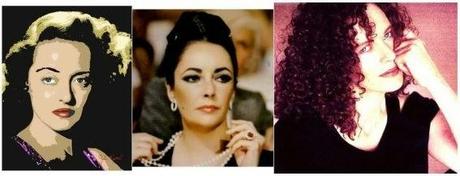
Bette Davis, Elizabeth Taylor, Judy Davis
The Metzinger Sisters of Silver Scenes are hosting a classic film event,The Great Imaginary Film Blogathon - and this is my entry. Click here for links to participating blogs.~
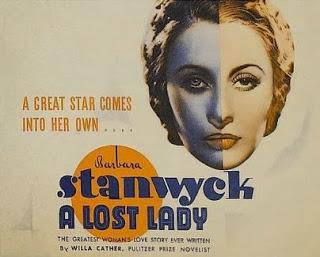
The tale unfolds from the point of view of its narrator, a young Midwestern woman named Nellie, who grew up enchanted by the local legend of a great romance that had taken place not too many years before she was born. Myra Driscoll had been the pampered only heir of her great-uncle, the wealthiest man in town. Though well-educated and handsome, Oswald Henshawe was of more humble origins, and the love that developed between the two was unacceptable to Myra's guardian. Myra threw away the certain inheritance of most of her great-uncle's enormous fortune when she defied him and eloped with Oswald. For young Nellie, Myra and Oswald's "runaway marriage" was "the most interesting, indeed the only interesting" story among those told on "holidays or at family dinners."
Myra had been taken in by her great-uncle when she was orphaned in childhood. He took her traveling with him to Europe, had her portrait painted by an esteemed painter, lavished her with clothing and jewelry as well as a riding horse and "a Steinway piano." She was spirited and witty and pretty and her guardian took pride in her. Though she enjoyed a close, affectionate relationship with her uncle, she was also proud and willful. When he solemnly promised he would "cut her off without a penny" if she married Oswald, she didn't react immediately. Some months later, though, Myra went out on a sleigh-ride with friends and never returned. She and Oswald met at a pre-arranged time and place, were married with his parents and her friends on hand and departed in the wee hours on an express train.
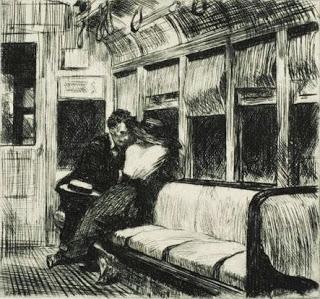
Drawing by Edward Hopper
The Myra we glimpse through Nellie's reminiscences of the stories she's been told all her life is passionate, impulsive, determined and full of self-confidence. The Myra we encounter when Nellie meets her in person is much older and very worldly. Myra and Oswald return to the small town 25 years after their elopement and Nellie, now 15, is finally introduced to the couple she has idealized as storybook lovers. She meets Myra first and is both bewitched and intimidated by the still-handsome but heavier-than-expected middle-aged woman. Myra's "charming, fluent voice, her clear light enunciation" bewilders Nellie, who also notes that her "sarcasm was so quick, so fine at the point - it was like being touched by a metal so cold that one doesn't know whether one is burned or chilled." Oswald is less imposing though also charismatic, and Nellie is captivated by his "dark and soft" eyes, shaped "exactly like half-moons." She observes "something about him that suggested personal bravery, magnanimity, and a fine, generous way of doing things." Nellie was more comfortable with Oswald than Myra, "because he did not frighten one so much." By the time the Henshawes leave days later, it has been decided that Nellie and her aunt will spend the Christmas holidays in New York and stay at a hotel near Oswald and Myra's apartment on Madison Square.
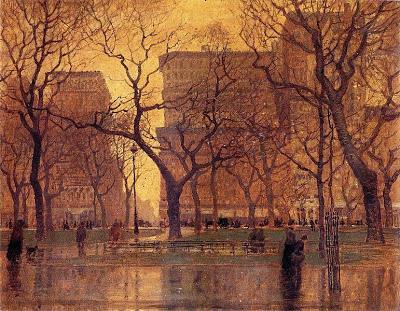
Madison Square painted by Paul Cornoyer, circa 1900
Once in New York, Nellie falls instantly in love with the couple's apartment in a brownstone on the north side of the Square. She enthusiastically takes in every detail - including long velvet curtains "lined with that rich cream-colour that lies under the blue skin of ripe figs." She is dazzled at the celebrity-studded New Years' Eve party the Henshawe's host, and enthralled when an opera star sings an aria from Bellini's Norma to piano accompaniment. But she also observes first-hand a darker side to the Henshawe marriage. After spending a pleasant day with Myra in Central Park, Nellie notices in her friend what seems an "insane ambition" when the woman offhandedly reveals her deep disappointment that her lifestyle isn't at all grand enough to suit her. Then, finally, Nellie walks in on the pair in the midst of a ferocious argument. Myra has found a key on Oswald's key-ring that he cannot or will not explain to her satisfaction. Already, Nellie is aware that a young woman of Oswald's acquaintance has given him a gift of topaz cufflinks and that, to avoid Myra's jealous wrath, he had asked her aunt to pretend they were a Christmas present from her. As Nellie and her aunt leave New York, Myra makes sure to tell them that she knows the cufflinks were not a gift from the aunt, "I was sure to find out, I always do," she says. Nellie will not see the Henshawes for another ten years and when she does encounter them again, it comes as a complete surprise.
At 25, Nellie ventures, without much conviction, to a West Coast city (reminiscent of Los Angeles then) to teach. She takes rooms in an apartment-hotel and once there finds that the Henshawes are living in the same building. Their circumstances are much reduced and Myra, now a wheelchair-bound invalid, is dying. Oswald, who holds a low-paying job with the city while carefully tending to his wife's needs, looks far older than his years. Myra appears to Nellie "strong and broken, generous and tyrannical, a witty and rather wicked old woman." Those traits the younger woman had admired and disliked have become ever more distilled.
As death approaches, Myra grows more demanding and difficult, as does her dark resentment of Oswald. She is openly suspicious of him and seems to blame him for her every discomfort and complaint. On one particularly bad night she laments that she must "die like this, alone with my mortal enemy..." Nellie, chilled as she listens to these bitter words, reflects that "...violent natures like hers sometimes turn against themselves..."

~
I’ve envisioned many actresses in the role of Myra Henshawe.
A rich, multifaceted character like Myra would have tantalized Miss Bette Davis during her heyday. With William Wyler in the director’s chair, Davis had turned in three outstanding performances – in Jezebel (1938), The Letter (1940) and The Little Foxes (1941), all of them earning Best Actress Oscar nominations for her, and Jezebel bringing the gold statuette. And all three characters possessed traits in common with Myra – spoiled, impetuous Julie, manipulative Leslie Crosbie and fierce Regina Giddens. So, with Wyler directing Davis and an evocative score by Max Steiner, My Mortal Enemy could easily have been another stellar Warner Bros. release during Hollywood’s Golden Age. While Warners might’ve been inclined to put George Brent or Herbert Marshall in the role of Oswald, the studio’s best bet would’ve been Paul Henreid. It seems to me, though, that another actor, someone like Lew Ayres, would've been a better fit.
I’ve also imagined My Mortal Enemy as a Technicolor production from the 1950s starring Deborah Kerr and Gregory Peck. Kerr’s lofty poise and ability to convey tumultuous emotions (Black Narcissus, From Here to Eternity, The Innocents) would've made for an interesting take on Myra, who was as haughty as she was passionate. Gregory Peck would have had no trouble portraying gentle, magnetically attractive Oswald. A good pick to direct might’ve been John Huston, who so often and successfully adapted literary gems (The Treasure of the Sierra Madre, Moby Dick). Huston also devised the vivid color concept of Moulin Rouge (1952) and directed both Kerr and Peck in popular films of the 1950s.
In the late 1960s, My Mortal Enemy could’ve provided a high profile vehicle as well as a solid follow-up to Who’s Afraid of Virginia Woolf? for Elizabeth Taylor and Richard Burton. The characters were within their range, but Liz & Dick's tabloid notoriety and worldwide superstardom at the time might well have overpowered the actual characters and story. Perhaps with Mike Nichols, who directed Virginia Woolf, at the helm, My Mortal Enemy could’ve been one of those memorable transitional films that bridged the shift from the studio era to the age of “easy riders and raging bulls.”
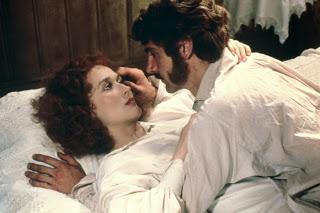
Meryl Streep, Jeremy Irons, The French Lieutenant's Woman
Meryl Streep was well established by the 1980s, and a complex and meaty role like Myra would’ve seemed tailor-made for her remarkable talents. Teaming her with Jeremy Irons, her co-star in The French Lieutenant’s Woman (1981), would’ve worked well. On the other hand, there’s the superb but relatively underrated Judy Davis, who emerged with My Brilliant Career (1979) and A Passage to India (1984), earning a Best Actress Oscar nomination for the latter. Davis possesses, along with an ability to express the deep anguish of a divided soul, the vivacity and sharp humor integral to Myra’s personality. I would pair Davis with William Hurt and put them under the direction of Martin Scorsese, who later rendered a moving and meticulous adaptation of Edith Wharton’s The Age of Innocence (1993).
By the early 1990s, adaptations of Willa Cather’s fiction for television had begun to surface. Perhaps the ban on “film” adaptations did not, technically, apply to broadcast media. A PBS production of O Pioneers!, starring Mary McDonnell, appeared in 1991 and a Hallmark Hall of Fame adaptation of the same novel appeared in 1992, starring Jessica Lange. In 1995, the USA Network aired a TV-movie version of My Ántonia, the second novel in Cather’s Prairie Trilogy (after Pioneers), starring Jason Robards and Eva Marie Saint. Finally, in 2001, the third book in the trilogy, The Song of the Lark, was adapted for PBS, starring Maximilian Schell and Alison Elliot.
Following the death of the last living executor of Willa Cather’s estate, Charles Cather, in 2011, The Cather Trust dropped the prohibition contained in her will against the publication of her letters and the adaptation of her fiction to film. In April of this year Knopf published The Selected Letters of Willa Cather. A dramatization of My Mortal Enemy, it seems, could actually come to pass. Cate Blanchett, now in her early 40s, is still young as well as old enough for the plum role of Myra. But the possibilities are endless - and fascinating.
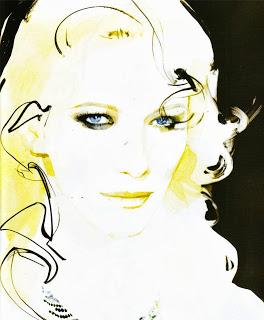
Cate Blanchett by David Downton

